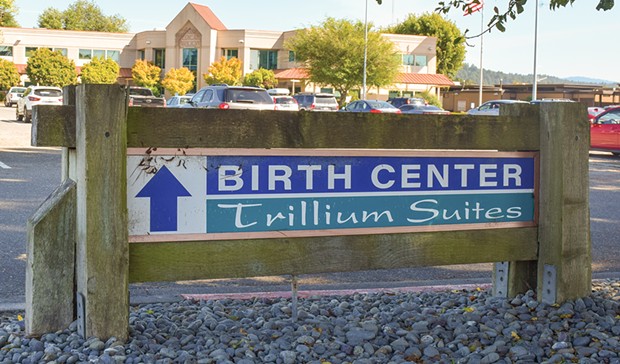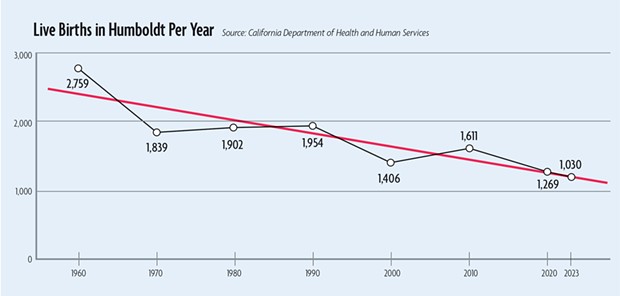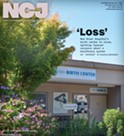'Loss'
Mad River Hospital's birth center to close, igniting layered concerns about a healthcare system in 'crisis'
By Thadeus Greenson [email protected] @ThadeusGreenson[
{
"name": "Top Stories Video Pair",
"insertPoint": "7",
"component": "17087298",
"parentWrapperClass": "fdn-ads-inline-content-block",
"requiredCountToDisplay": "1"
}
]
When Mad River Community Hospital recently announced it plans to suspend labor and delivery services in October, the news was met in the local community with a mixture of shock and grief as word spread via social media.
"Literally so sad to see this go," one local mother posted. "My birthing experience there and the staff were just so incredible."
"Wow, this is so sad," posted another. "All of my kids were born here."
In provider circles, however, the news, while sad, did not come as a surprise.
"While the timing of the closure was sooner than expected, we have all been anticipating this coming," said Emma Hackett, the pregnancy services medical director at Open Door Community Health Centers, noting most rural hospitals no longer offer obstetrics services. "Obstetrical services have been eliminated at hospitals all over the nation ... . Maternity care does not make money. Reimbursement has never been lower, while overhead continues to soar."
Indeed, the decision to shutter labor and delivery services at a hospital where they were once considered a crown jewel comes as part of a nationwide trend that providers warn could have dire consequences for maternal mortality rates and families experiencing what can be the most important moment in many people's lives. Meanwhile, others say the closure and what it means for expecting families underscores the hard reality of a for-profit medical system in which care delivery often hinges on what a patient can afford. It also leaves St. Joseph Hospital — a Catholic institution — as the only local option for families who want or need to give birth in a hospital setting, raising questions of both capacity and patient care.
'A Seven-figure Annual Loss'
In the hospital's press release announcing the "suspension" of labor and delivery services, Mad River Community Hospital CEO Douglas Shaw called the decision one of the hardest in his tenure, noting its once vaunted status as the "premier" childbirth provider in the county.
Shaw then offered a succinct rationale.
"Over the past four years, volumes have declined significantly to the point where we are performing, on average, less than 25 births per month," he said. "We used to average 60-plus births per month, which was necessary to fund the service line. At our current volume, [labor and delivery] has been sustaining a seven-figure annual loss for the past several years. When the decline in volume is combined with inadequate and stagnated reimbursement rates under Medi-Cal, unfunded mandates for seismic compliance and other significant challenges for rural healthcare, the continuation of L&D service will jeopardize the hospital's continued viability in the community."
The press release notes the hospital will continue to offer other gynecological services, like hysterectomies, laparoscopies and tubal ligations, while reinvesting the money saved from discontinuing labor and delivery services into a new psychiatric crisis stabilization unit and re-opening of home health services.
The hospital's halting of labor and delivery services falls in line with a national trend that already hit locally, with Providence's decision in 2021 to discontinue its obstetrics program at Redwood Memorial Hospital, merging it with that of St. Joseph Hospital. At the time, a Mad River Community Hospital spokesperson told the Times-Standard staff were saddened to hear the news, saying, "it is unfortunate that a large health care system from outside of the area has made sweeping decisions that impact the local community." She pledged that Mad River's "commitment to women's choice has not and will not waiver."
Three and a half years later, things look markedly different.
More than 50 maternity wards have closed in California since 2012, according to a CalMatters report, including four in the first months of 2024. The reasons are layered but can be simplified as follows: Labor and delivery units are unprofitable, particularly at smaller hospitals, because reimbursements are low and overhead is high.
Labor and delivery units are expensive to run. They must be staffed 24 hours a day, 365 days a year with specialized staff and equipment, with adjacent operating rooms and anesthesiologists at the ready, should something go wrong. Additionally, obstetrics sees some of the highest medical malpractice insurance rates because they face a proportionately high volume of lawsuits, with 64 percent of obstetrician-gynecologists having been sued, according to a study by the American Medical Association. Additionally, the units have been subject to the same inflationary pressures affecting all other sectors in recent years.
Reimbursement rates, meanwhile, are comparatively low, according to providers, particularly under Medi-Cal, California's Medicaid program for low-income residents, which pays for half of all births in the state but reimburses at lower rates than private insurance.
Tory Starr, Open Door's president and CEO, says reimbursement for obstetric healthcare across the board is insufficient, noting Open Door runs a $1 million annual deficit to "offer high-quality, comprehensive pregnancy services."
The Department of Health and Care Services increased Medi-Cal reimbursement rates for obstetrics services by 11 percent last year, effective Jan. 1, but providers say they still fall far below the cost of providing care. This seems particularly true at facilities — most commonly those in rural areas — with birth volumes that don't allow them to achieve economies of scale.
And Humboldt County's birth rate has been in steady decline, mirroring a statewide trend that is seeing Californians having half as many babies as they were 30 years ago.
According to state data, Humboldt County has similarly gone from seeing an average of 163 births a month in 1990 (down from 230 three decades earlier) to 106 per month in 2020. That number fell to 86 per month in 2023.
There are also indications Mad River is seeing a smaller percentage of the births that do occur locally. Providers say a number of factors have played into that trend.
Kim Ervin, who retired a few weeks ago after a decades-long career as a physician providing obstetrical and gynecological care locally, says one of the factors is likely the changing demographics of expectant mothers.
"You see more older women having babies, the trend toward women delaying childbirth until later in life," she says, adding that results in more high-risk pregnancies, with mothers more likely to choose St. Joseph because it has a neonatal intensive care unit on site.
By some metrics, St. Joseph Hospital has also improved maternity care. One of the first metrics many expecting mothers look at when deciding where to delivery their baby is the cesarean section rate, as most want a vaginal delivery and the environment that will best facilitate it. While St. Joseph's rate of cesarian births used to be much higher than Mad River's, it joined the California Maternal Quality Care Collaborative in 2017 and narrowed the gap, going from a 22-percent cesarean rate to 13.2 percent in the first year — well under the national benchmark of 23.9 percent.
Ervin says she also suspects challenges in retaining experienced nurses and reinvesting in the birth center, even with little things like a fresh coat of paint, have likely led more mothers to choose to deliver at St. Joseph in recent years.
And come October, those who prefer — or need — to give birth in a hospital setting will have no other local option.
Consolidation Concerns
When Providence decided to close the childbirth unit at Redwood Memorial Hospital a few years back, there was an immediate outcry from the community, with many voicing concern about the added 30-minute drive laboring mothers in the Eel River Valley and Southern Humboldt would face. Families in the northern and eastern reaches of Humboldt County now face similar concerns, with mothers in McKinleyville, Orick or Willow Creek now facing an added 20 minutes of travel time to receive care.
And in cases of emergency, that can make all the difference. According to a 2022 report by March of Dimes, a nonprofit dedicated to improving maternal healthcare, traveling more than 30 minutes to an obstetric hospital increases the probability of maternal deaths or severe health episodes by 9 percent.
But even absent emergencies, the consolidation of all Humboldt County's hospital delivery services to St. Joseph raises capacity concerns.
Christian Hill, a spokesperson for the hospital, says it delivered 667 babies in 2023 — about 65 percent of those born in the county, according to state data. Hill did not directly answer a Journal inquiry asking how many simultaneous deliveries the childbirth center at St. Joseph and current staffing levels can accommodate.
"Providence is deeply committed to serving our community and we understand that changes to these services can have a significant impact," he said in an email. "We're working hand in hand with Mad River Hospital, Open Door Health Centers and other community partners to ensure that we maintain safe, high-quality care for moms and babies in Humboldt County. As with any potential increase in patient demand at our hospitals, we will position ourselves so that we meet the needs of our community."
Ervin, for her part, says she's heard there are some days when St. Joseph's birth center has "trouble keeping up with existing volume," saying she's concerned it may not be able to sustain the increased volume that will come with Mad River's closure, to say nothing of what might happen if birth trends reverse in the coming years.
"Can we really deliver all these babies safely, that used to be delivered at three hospitals, at one?" Ervin asked.
There are other concerns, as well.
When the hospital system shuttered obstetrical services at Redwood Memorial, one of the reasons it cited was a shortage of providers locally. Ervin says she fears the suspension of deliveries at Mad River could exacerbate this, leaving St. Joseph as the primary option for recruiting obstetricians. Because it's a Catholic hospital guided by the Ethical and Religious Directives for Catholic Health Care Services, St. Joseph prohibits providers from promoting contraceptive care or doing direct sterilization procedures, which Ervin says may be a non-starter for many physicians with options about where they want to work.
"Most OBGYNs now are women," Ervin says. "Most women who go into obstetrics and gynecology are not going to be happy about signing a contract saying you're not going to promote contraceptive care to be a clinician at St. Joseph. They're not going to. It's not good. Not having Mad River, yeah, it's not going to help us recruit OBGYNs here."
Asked about whether physicians practicing at St. Joseph have to sign a contract saying they won't promote contraceptive care, Hill didn't answer directly.
"Providence deeply respects the doctor-patient relationship," he wrote in an email. "Each patient's unique needs are evaluated on a case-by-case basis, and treatment decisions are made privately between patients and their care teams. At Providence St. Joseph Hospital Eureka, physicians are expected to follow sound medical practice and the Ethical and Religious Directives for Catholic Health Care Services."
Those directives, however, do prohibit physicians from promoting contraceptive care and providing sterilization services unless "medically necessary."
That stance can result in care that deviates from what many providers see as best practices.
For example, for pregnant women who have decided they do not want to have another child, it's common for non-religious hospitals to perform a tubal ligation sterilization either during a cesarean section or shortly after vaginal birth. This both streamlines recovery and alleviates the need for a second procedure, decreasing associated risks, while postponing a tubal ligation also increases the risk of an unwanted pregnancy.
The reality of the diminished choice that consolidating hospital deliveries to St. Joseph could bring seemed to strike a chord with some locally as they grieved the looming loss of Mad River's delivery services.
"This is devastating," posted one woman. "I do not trust St. Joes as a Catholic institution with my reproductive health."
'Our Healthcare System is Failing'
As a licensed midwife and co-owner of Moonstone Midwives Birth Center, the first and only freestanding licensed birth center locally, Laura Doyle has watched the conversation around Mad River's labor and delivery services play out from a unique vantage point.
"We're here, we're open and we have two birth rooms, and we have the capacity to do so many more births," Doyle says, with the center's website boasting that the rooms have "built-in-birth tubs, queen sized beds and private bathrooms," blending "tranquil and elegant style" with access to midwife services.
The center also offers home birth services, Doyle says, noting it's been in business about a decade and she's proud to be operating in Humboldt County, where residents have worked to build community birth models.
"The people who taught us, their fight was getting licensed," Doyle says, adding that fight was successful, leading the way to licensed midwives and certified nurse midwives. "Our fight is accessibility — how can we get everyone these services?"
Moonstone Midwives does not accept Medi-Cal, Doyle says, saying it "has never been a viable option because reimbursements are so low." She says the center's patients pay up front for its services, then those with private insurance get reimbursed after it's billed. She says she's fully aware this makes the center's services inaccessible to many in Humboldt County, where one in five households lives in poverty.
Doyle says she's been working to try to change that, looking to meet with Partnership, the nonprofit that manages Medi-Cal on the North Coast, to lobby for higher reimbursement rates and speaking with other birth centers in the state to look at ways to make services more affordable and accessible.
Starr at Open Door said in a statement emailed to the Journal that it's important to remember the announced suspension of Mad River's labor and delivery services is just the latest domino to fall, though he suspects more are on the way.
"Open Door is now the largest provider of obstetrics services in Humboldt County," he says. "This is not a boast; it's a warning that our healthcare system is failing. ... Compounding inadequate reimbursement for healthcare services is a regulatory environment that has become prohibitively expensive. Through the state's inaction and the health insurance industry's greed, California's problem is now a crisis."
Hackett, Open Door's pregnancy services medical director, called on local residents concerned about the situation to contact their legislators, urging them to fight for maternity and women's health care "to prevent this from continuing to happen."
Doyle says Moonstone Midwives has received a flood of interest in the days since Mad River's announcement.
"We have a ton of consults scheduled this week and next week," she says. "The phones have been ringing, for sure."
But the center is only able to provide care to those who can afford it, which Doyle says she sees as a deep inequity, reiterating that "accessibility is definitely the fight of our career." And while that can be said of inequities across the healthcare delivery system, she says it feels especially acute when it comes to childbirth.
"Birth, historically, is a huge part of a community and a society," she says. "How we treat birth in the community is the foundation of how we treat people."
Thadeus Greenson (he/him) is the Journal's news editor. Reach him at (707) 442-1400, extension 321, or [email protected].
more from the author
-
Eureka City Schools to Talk Jacobs, Grand Jury Response
- Aug 29, 2024
-
Eureka City Schools to Talk Jacobs, Grand Jury Response
- Aug 27, 2024
-
Freeing Aaron Bjorkstrand
Arrested at 15 and incarcerated for 26 years, a McKinleyville man works to start anew
- Aug 22, 2024
- More »
Latest in News
Readers also liked…
-
'To Celebrate Our Sovereignty'
Yurok Tribe to host gathering honoring 'ultimate river warrior' on the anniversary of the U.S. Supreme Court ruling that changed everything
- Jun 8, 2023
-
Pride in Full Stride
- Jun 29, 2023

































